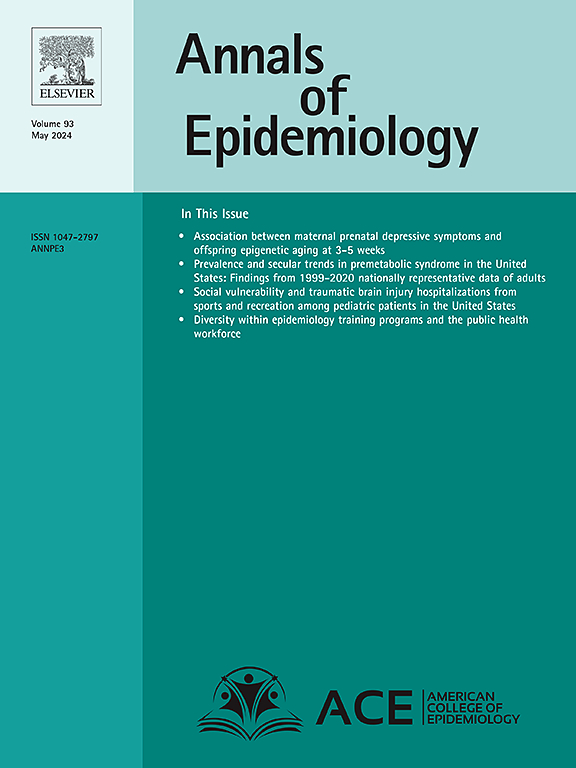极早产/极低出生体重的年轻人的生育能力:个体参与者数据荟萃分析
IF 3.3
3区 医学
Q1 PUBLIC, ENVIRONMENTAL & OCCUPATIONAL HEALTH
引用次数: 0
摘要
目的评估极早产或极低出生体重(VP/VLBW)成人与足月出生对照组之间的生育能力是否存在差异,VP/VLBW与生育能力的关联是否因性别而异,以及哪些个体因素与VP/VLBW成人的生育能力相关。研究设计:从两个国际联盟中确定了VP/VLBW和足月成人生育能力评估的前瞻性纵向队列:欧洲早产儿儿童和成人研究(recapp -Preterm)和早产儿成人国际合作(APIC)。使用单阶段方法收集和分析新生儿、医疗、社会人口和生育变量的个人参与者数据(IPD)。结果纳入7个队列,931例VP/VLBW和1363例足月出生的年轻人(评估时平均年龄为23至30岁)。VP/VLBW和足月出生的年轻人在生育能力(即生育孩子)方面没有显著差异(OR 1.48, 95 % CI 0.99-2.21)。性别无调节作用(OR 0.87, 95 % CI 0.53-1.42)。在VP/VLBW年轻人中,较高的生育率与女性、较高的评估年龄、已婚/同居、没有儿童神经感觉障碍、低水平的母亲和自己的教育水平显著相关。结论svp /VLBW与青壮年低生育能力无相关性。性并不能缓和这种联系。除了儿童期神经感觉障碍外,主要的社会人口因素(伴侣、母亲和自己的教育)与VP/VLBW年轻人的生育能力有关。到目前为止,证据仅限于20世纪90年代 的早期生殖窗口,需要进一步随访到成年期,以确定VP/VLBW出生后的生育能力。本文章由计算机程序翻译,如有差异,请以英文原文为准。
Fertility of young adults born very preterm/very low birth weight: An individual participant data meta-analysis
Objectives
To assess whether there are differences in fertility between adults born very preterm or at very low birth weight (VP/VLBW) with term-born controls, whether the association of VP/VLBW with fertility differs by sex, and which individual factors are associated with fertility among VP/VLBW adults.
Study design
Prospective longitudinal cohorts with fertility assessed in VP/VLBW and term-born adults were identified from two international consortia: Research on European Children and Adults Born Preterm (RECAP-Preterm), and Adults Born Preterm International Collaboration (APIC). Individual participant data (IPD) on neonatal, medical, sociodemographic, and fertility variables were collected and analyzed using a one-stage approach.
Results
Seven cohorts with 931 VP/VLBW and 1363 term-born young adults (mean ages at assessment ranged from 23 to 30 years) were included. VP/VLBW and term-born young adults did not significantly differ in fertility (i.e., having children) (OR 1.48, 95 % CI 0.99–2.21). No moderation effect of sex could be confirmed (OR 0.87, 95 % CI 0.53–1.42). Among VP/VLBW young adults, higher fertility was significantly associated with female sex, higher age at assessment, being married/cohabiting, the absence of childhood neurosensory impairment, and low levels of maternal and own education.
Conclusions
VP/VLBW is not associated with lower fertility in young adults. Sex does not moderate this association. In addition to childhood neurosensory impairment, mainly sociodemographic factors (partnering, maternal and own education) are associated with fertility in VP/VLBW young adults. The evidence is limited so far to the early reproductive window in the 20 s, further follow-up into established adulthood will be required for definite answers on fertility after VP/VLBW birth.
求助全文
通过发布文献求助,成功后即可免费获取论文全文。
去求助
来源期刊

Annals of Epidemiology
医学-公共卫生、环境卫生与职业卫生
CiteScore
7.40
自引率
1.80%
发文量
207
审稿时长
59 days
期刊介绍:
The journal emphasizes the application of epidemiologic methods to issues that affect the distribution and determinants of human illness in diverse contexts. Its primary focus is on chronic and acute conditions of diverse etiologies and of major importance to clinical medicine, public health, and health care delivery.
 求助内容:
求助内容: 应助结果提醒方式:
应助结果提醒方式:


